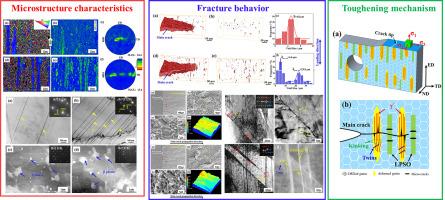挤压态Mg-9Gd-4Y-1Zn-0.5Zr合金的层状γ′相组织裁剪和断裂韧性增强
IF 13.8
1区 材料科学
Q1 METALLURGY & METALLURGICAL ENGINEERING
引用次数: 0
摘要
在本研究中,通过调整均匀化工艺,在挤压态Mg-9Gd-4Y-1Zn-0.5Zr (wt.%)合金中产生了大量片状γ′相,并均匀分布在晶粒内部,从而显著提高了拉伸强度和断裂韧性。值得注意的是,与含有块状长周期堆积有序相(LPSO)的合金相比,在α-Mg基体中引入片状γ′相时,合金的断裂韧性可达到29.7 MPa·m1/2,提高了27. %。这种优异的抗断裂性能主要是由于沿垂直于主断口的γ′相界面产生的密集微裂纹引起的分层增韧。由于片状γ′相的存在,断口形貌发生了明显的变化,主要表现为深韧窝和明显的主裂纹偏转,从而提高了塑性能耗散和断裂韧性。断口附近变形组织的特征表明,与层状γ′相的相互作用激活了扭结,抑制了孪晶的扩展。这种变形行为可以有效地阻止裂纹扩展,从而提高材料的抗断裂性能。此外,对断裂合金的x射线计算机断层扫描分析显示了空洞的分布和大小,表明延长的空洞优先成核并平行于片层状γ′相扩展。因此,在三轴应力状态下的变形机制涉及层状γ′相诱发的分层、裂纹挠曲和空洞形成之间复杂的相互作用。通过应用定制的预处理热处理工艺,可以实现微观组织内相成分的控制,从而提高镁合金的力学性能。该研究有望为Mg-Gd-Y-Zn-Zr的断裂行为提供全面的理解,特别是强调层状γ′相和LPSO相在整体力学性能优化中的协同作用。本文章由计算机程序翻译,如有差异,请以英文原文为准。

Microstructure tailoring and enhanced fracture toughness in as-extruded Mg-9Gd-4Y-1Zn-0.5Zr alloy via lamellar γ’ phase
In this study, by adjusting the homogenization process, numerous lamellar-shaped γ’ phases are generated and uniformly distributed throughout the grain interior within as-extruded Mg-9Gd-4Y-1Zn-0.5Zr (wt.%) alloy, leading to a remarkable increase enhancement in both tensile strength and fracture toughness. Notably, as compared to the alloy containing block-shaped long-period stacking-ordered (LPSO) phase, when the lamellar-shaped γ’ phase is introduced within the α-Mg matrix, the fracture toughness of 29.7 MPa·m1/2 can be achieved with a 27 % improvement. This superior fracture resistance is mainly attributed to the delamination toughening derived from the intensive micro-cracks occurring along γ’ phase interfaces oriented perpendicular to the primary fracture surface. Owing to the presence of lamellar-shaped γ’ phase, the fracture morphology can be significantly changed and characterized with deep dimples and pronounced deflection of main crack, which collectively contribute to the enhanced plastic energy dissipation and fracture toughness. The characteristics of deformed microstructure near the fracture surface demonstrate the activation of kinking and the inhibition of twin propagation due to the interactions with lamellar γ’ phase. Such deformation behavior can effectively impede the crack propagation and contribute to the superior fracture resistance. Besides, the X-ray computed tomography analysis of the fractured alloy exhibits the distribution and size of voids, indicating that the prolate voids preferentially nucleate and propagate parallel to the lamellar γ’ phase. Accordingly, the deformation mechanisms under a triaxial stress state involve the intricate interplay between lamellar γ' phase-induced delamination, crack deflection as well as void formation. Through the application of tailored pre-treatment heat treatment processes, the control of phase constituents within the microstructure can be achieved to improve the mechanical properties of Mg alloys. It is anticipated to provide a comprehensive understanding of the fracture behavior of Mg-Gd-Y-Zn-Zr, with particular emphasis on the synergistic effects of lamellar γ' phase and LPSO phase in the optimization of overall mechanical performance.
求助全文
通过发布文献求助,成功后即可免费获取论文全文。
去求助
来源期刊

Journal of Magnesium and Alloys
Engineering-Mechanics of Materials
CiteScore
20.20
自引率
14.80%
发文量
52
审稿时长
59 days
期刊介绍:
The Journal of Magnesium and Alloys serves as a global platform for both theoretical and experimental studies in magnesium science and engineering. It welcomes submissions investigating various scientific and engineering factors impacting the metallurgy, processing, microstructure, properties, and applications of magnesium and alloys. The journal covers all aspects of magnesium and alloy research, including raw materials, alloy casting, extrusion and deformation, corrosion and surface treatment, joining and machining, simulation and modeling, microstructure evolution and mechanical properties, new alloy development, magnesium-based composites, bio-materials and energy materials, applications, and recycling.
 求助内容:
求助内容: 应助结果提醒方式:
应助结果提醒方式:


